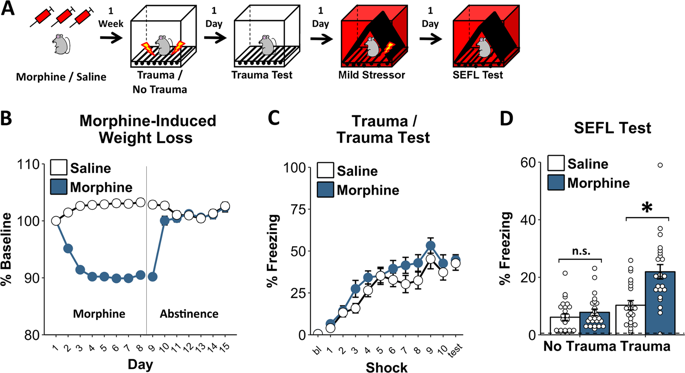当前位置:
X-MOL 学术
›
Neuropsychopharmacology
›
论文详情
Our official English website, www.x-mol.net, welcomes your
feedback! (Note: you will need to create a separate account there.)
Chronic opioid pretreatment potentiates the sensitization of fear learning by trauma.
Neuropsychopharmacology ( IF 6.6 ) Pub Date : 2019-12-02 , DOI: 10.1038/s41386-019-0559-5 Zachary T Pennington 1, 2, 3 , Jeremy M Trott 1, 2 , Abha K Rajbhandari 1, 2 , Kevin Li 1 , Wendy M Walwyn 4, 5 , Christopher J Evans 4, 5 , Michael S Fanselow 1, 2, 4
Neuropsychopharmacology ( IF 6.6 ) Pub Date : 2019-12-02 , DOI: 10.1038/s41386-019-0559-5 Zachary T Pennington 1, 2, 3 , Jeremy M Trott 1, 2 , Abha K Rajbhandari 1, 2 , Kevin Li 1 , Wendy M Walwyn 4, 5 , Christopher J Evans 4, 5 , Michael S Fanselow 1, 2, 4
Affiliation

|
Despite the large comorbidity between PTSD and opioid use disorders, as well as the common treatment of physical injuries resulting from trauma with opioids, the ability of opioid treatments to subsequently modify PTSD-related behavior has not been well studied. Using the stress-enhanced fear learning (SEFL) model for PTSD, we characterized the impact of chronic opioid regimens on the sensitization of fear learning seen following traumatic stress in mice. We demonstrate for the first time that chronic opioid pretreatment is able to robustly augment associative fear learning. Highlighting aversive learning as the cognitive process mediating this behavioral outcome, these changes were observed after a considerable period of drug cessation, generalized to learning about multiple aversive stimuli, were not due to changes in stimulus sensitivity or basal anxiety, and correlated with a marker of synaptic plasticity within the basolateral amygdala. Additionally, these changes were not observed when opioids were given after the traumatic event. Moreover, we found that neither reducing the frequency of opioid administration nor bidirectional manipulation of acute withdrawal impacted the subsequent enhancement in fear learning seen. Given the fundamental role of associative fear learning in the generation and progression of PTSD, these findings are of direct translational relevance to the comorbidity between opioid dependence and PTSD, and they are also pertinent to the use of opioids for treating pain resulting from traumas involving physical injuries.
中文翻译:

慢性阿片类药物预处理增强了创伤对恐惧学习的敏感性。
尽管 PTSD 和阿片类药物使用障碍之间存在大量共病,以及阿片类药物创伤导致的身体损伤的常见治疗,但阿片类药物治疗随后改变 PTSD 相关行为的能力尚未得到充分研究。使用 PTSD 的压力增强恐惧学习 (SEFL) 模型,我们描述了慢性阿片类药物方案对小鼠创伤性压力后恐惧学习敏感性的影响。我们首次证明慢性阿片类药物预处理能够有力地增强联想恐惧学习。强调厌恶学习作为调节这种行为结果的认知过程,在相当长的一段时间戒毒后观察到这些变化,概括为了解多种厌恶刺激,不是由于刺激敏感性或基础焦虑的变化,而是与基底外侧杏仁核内突触可塑性的标志物相关。此外,在创伤事件后给予阿片类药物时未观察到这些变化。此外,我们发现无论是降低阿片类药物给药的频率还是双向操作急性戒断都不会影响随后看到的恐惧学习的增强。鉴于联想恐惧学习在 PTSD 的产生和进展中的基本作用,这些发现与阿片类药物依赖和 PTSD 之间的共病有直接的转化相关性,它们也与使用阿片类药物治疗涉及身体创伤引起的疼痛有关。受伤。此外,在创伤事件后给予阿片类药物时未观察到这些变化。此外,我们发现无论是降低阿片类药物给药的频率还是双向操作急性戒断都不会影响随后看到的恐惧学习的增强。鉴于联想恐惧学习在 PTSD 的产生和进展中的基本作用,这些发现与阿片类药物依赖和 PTSD 之间的共病有直接的转化相关性,它们也与使用阿片类药物治疗涉及身体创伤引起的疼痛有关。受伤。此外,在创伤事件后给予阿片类药物时未观察到这些变化。此外,我们发现无论是降低阿片类药物给药的频率还是双向操作急性戒断都不会影响随后看到的恐惧学习的增强。鉴于联想恐惧学习在 PTSD 的产生和进展中的基本作用,这些发现与阿片类药物依赖和 PTSD 之间的共病有直接的转化相关性,它们也与使用阿片类药物治疗涉及身体创伤引起的疼痛有关。受伤。我们发现,无论是减少阿片类药物给药的频率还是双向操作急性戒断都不会影响随后看到的恐惧学习的增强。鉴于联想恐惧学习在 PTSD 的产生和进展中的基本作用,这些发现与阿片类药物依赖和 PTSD 之间的共病有直接的转化相关性,它们也与使用阿片类药物治疗涉及身体创伤引起的疼痛有关。受伤。我们发现,无论是减少阿片类药物给药的频率还是双向操作急性戒断都不会影响随后看到的恐惧学习的增强。鉴于联想恐惧学习在 PTSD 的产生和进展中的基本作用,这些发现与阿片类药物依赖和 PTSD 之间的共病有直接的转化相关性,它们也与使用阿片类药物治疗涉及身体创伤引起的疼痛有关。受伤。
更新日期:2019-12-02
中文翻译:

慢性阿片类药物预处理增强了创伤对恐惧学习的敏感性。
尽管 PTSD 和阿片类药物使用障碍之间存在大量共病,以及阿片类药物创伤导致的身体损伤的常见治疗,但阿片类药物治疗随后改变 PTSD 相关行为的能力尚未得到充分研究。使用 PTSD 的压力增强恐惧学习 (SEFL) 模型,我们描述了慢性阿片类药物方案对小鼠创伤性压力后恐惧学习敏感性的影响。我们首次证明慢性阿片类药物预处理能够有力地增强联想恐惧学习。强调厌恶学习作为调节这种行为结果的认知过程,在相当长的一段时间戒毒后观察到这些变化,概括为了解多种厌恶刺激,不是由于刺激敏感性或基础焦虑的变化,而是与基底外侧杏仁核内突触可塑性的标志物相关。此外,在创伤事件后给予阿片类药物时未观察到这些变化。此外,我们发现无论是降低阿片类药物给药的频率还是双向操作急性戒断都不会影响随后看到的恐惧学习的增强。鉴于联想恐惧学习在 PTSD 的产生和进展中的基本作用,这些发现与阿片类药物依赖和 PTSD 之间的共病有直接的转化相关性,它们也与使用阿片类药物治疗涉及身体创伤引起的疼痛有关。受伤。此外,在创伤事件后给予阿片类药物时未观察到这些变化。此外,我们发现无论是降低阿片类药物给药的频率还是双向操作急性戒断都不会影响随后看到的恐惧学习的增强。鉴于联想恐惧学习在 PTSD 的产生和进展中的基本作用,这些发现与阿片类药物依赖和 PTSD 之间的共病有直接的转化相关性,它们也与使用阿片类药物治疗涉及身体创伤引起的疼痛有关。受伤。此外,在创伤事件后给予阿片类药物时未观察到这些变化。此外,我们发现无论是降低阿片类药物给药的频率还是双向操作急性戒断都不会影响随后看到的恐惧学习的增强。鉴于联想恐惧学习在 PTSD 的产生和进展中的基本作用,这些发现与阿片类药物依赖和 PTSD 之间的共病有直接的转化相关性,它们也与使用阿片类药物治疗涉及身体创伤引起的疼痛有关。受伤。我们发现,无论是减少阿片类药物给药的频率还是双向操作急性戒断都不会影响随后看到的恐惧学习的增强。鉴于联想恐惧学习在 PTSD 的产生和进展中的基本作用,这些发现与阿片类药物依赖和 PTSD 之间的共病有直接的转化相关性,它们也与使用阿片类药物治疗涉及身体创伤引起的疼痛有关。受伤。我们发现,无论是减少阿片类药物给药的频率还是双向操作急性戒断都不会影响随后看到的恐惧学习的增强。鉴于联想恐惧学习在 PTSD 的产生和进展中的基本作用,这些发现与阿片类药物依赖和 PTSD 之间的共病有直接的转化相关性,它们也与使用阿片类药物治疗涉及身体创伤引起的疼痛有关。受伤。











































 京公网安备 11010802027423号
京公网安备 11010802027423号